 | –≠–ª–µ–∫—Ç—Ä–æ–Ω–Ω—ã–π –∫–æ–º–ø–æ–Ω–µ–Ω—Ç: FM24C08U | –°–∫–∞—á–∞—Ç—å:  PDF PDF  ZIP ZIP |

1
www.fairchildsemi.com
FM24C04U/05U Rev. A.3
FM24C04U/05U ≠ 4K-Bit Standard 2-Wire Bus Interface Serial EEPROM
August 2000
© 2000 Fairchild Semiconductor International
FM24C04U/05U ≠ 4K-Bit Standard 2-Wire Bus
Interface Serial EEPROM
General Description
The FM24C04U/05U devices are 4096 bits of CMOS non-volatile
electrically erasable memory. These devices conform to all speci-
fications in the Standard IIC 2-wire protocol. They are designed to
minimize device pin count and simplify PC board layout require-
ments.
The upper half (upper 2Kbit) of the memory of the FM24C05U can
be write protected by connecting the WP pin to V
CC
. This section of
memory then becomes unalterable unless WP is switched to V
SS
.
This communications protocol uses CLOCK (SCL) and DATA
I/O (SDA) lines to synchronously clock data between the master
(for example a microprocessor) and the slave EEPROM device(s).
The Standard IIC protocol allows for a maximum of 16K of
EEPROM memory which is supported by the Fairchild family in
2K, 4K, 8K, and 16K devices, allowing the user to configure the
memory as the application requires with any combination of
EEPROMs. In order to implement higher EEPROM memory
densities on the IIC bus, the Extended IIC protocol must be used.
(Refer to the FM24C32 or FM24C65 datasheets for more informa-
tion.)
Fairchild EEPROMs are designed and tested for applications requir-
ing high endurance, high reliability and low power consumption.
Block Diagram
Features
I Extended operating voltage 2.7V ≠ 5.5V
I 400 KHz clock frequency (F) at 2.7V - 5.5V
I 200µA active current typical
10
µA standby current typical
1
µA standby current typical (L)
0.1
µA standby current typical (LZ)
I IIC compatible interface
≠ Provides bi-directional data transfer protocol
I Sixteen byte page write mode
≠ Minimizes total write time per byte
I Self timed write cycle
Typical write cycle time of 6ms
I Hardware Write Protect for upper half (FM24C05U only)
I Endurance: 1,000,000 data changes
I Data retention greater than 40 years
I Packages available: 8-pin DIP, 8-pin SO, and 8-pin TSSOP
I Available in three temperature ranges
- Commercial: 0
∞ to +70∞C
- Extended (E): -40
∞ to +85C
- Automotive (V): -40
∞ to +125∞C
H.V. GENERATION
TIMING &CONTROL
E2PROM
ARRAY
YDEC
DATA REGISTER
XDEC
CONTROL
LOGIC
WORD
ADDRESS
COUNTER
SLAVE ADDRESS
REGISTER &
COMPARATOR
START
STOP
LOGIC
CK
DIN
R/W
SDA
SCL
VSS
WP
VCC
DOUT
A2
A1

2
www.fairchildsemi.com
FM24C04U/05U Rev. A.3
FM24C04U/05U ≠ 4K-Bit Standard 2-Wire Bus Interface Serial EEPROM
NC
A1
A2
VSS
VCC
NC
SCL
SDA
8
7
6
5
1
2
3
4
24C04
Connection Diagrams
Dual-in-Line Package (N), SO Package (M8) and TSSOP Package (MT8)
See Package Number N08E, M08A and MTC08
Pin Names
A1,A2
Device Address Inputs
V
SS
Ground
SDA
Serial Data I/O
SCL
Serial Clock Input
NC
No Connection
V
CC
Power Supply
Dual-in-Line Package (N), SO Package (M8) and TSSOP Package (MT8)
See Package Number N08E, M08A and MTC08
Pin Names
A1,A2
Device Address Inputs
V
SS
Ground
SDA
Serial Data I/O
SCL
Serial Clock input
WP
Write Protect
V
CC
Power Supply
NC
No Connection
NC
A1
A2
VSS
VCC
WP
SCL
SDA
8
7
6
5
1
2
3
4
24C05

3
www.fairchildsemi.com
FM24C04U/05U Rev. A.3
FM24C04U/05U ≠ 4K-Bit Standard 2-Wire Bus Interface Serial EEPROM
Ordering Information
FM
24
C
XX
U
F
LZ
E
XXX
Letter
Description
Package
N
8-pin DIP
M8
8-pin SOIC
MT8
8-pin TSSOP
Temp. Range
Blank
0 to 70
∞C
V
-40 to +125
∞C
E
-40 to +85
∞C
Voltage Operating Range
Blank
4.5V to 5.5V
L
2.7V to 5.5V
LZ
2.7V to 5.5V and
<1
µA Standby Current
SCL Clock Frequency
Blank
100KHz
F
400KHz
Process
U
Ultralite CS100UL
Density
04
4K
05
4K with Write Protect
C
CMOS Technology
Interface
24
IIC
FM
Fairchild Non-Volatile
Memory
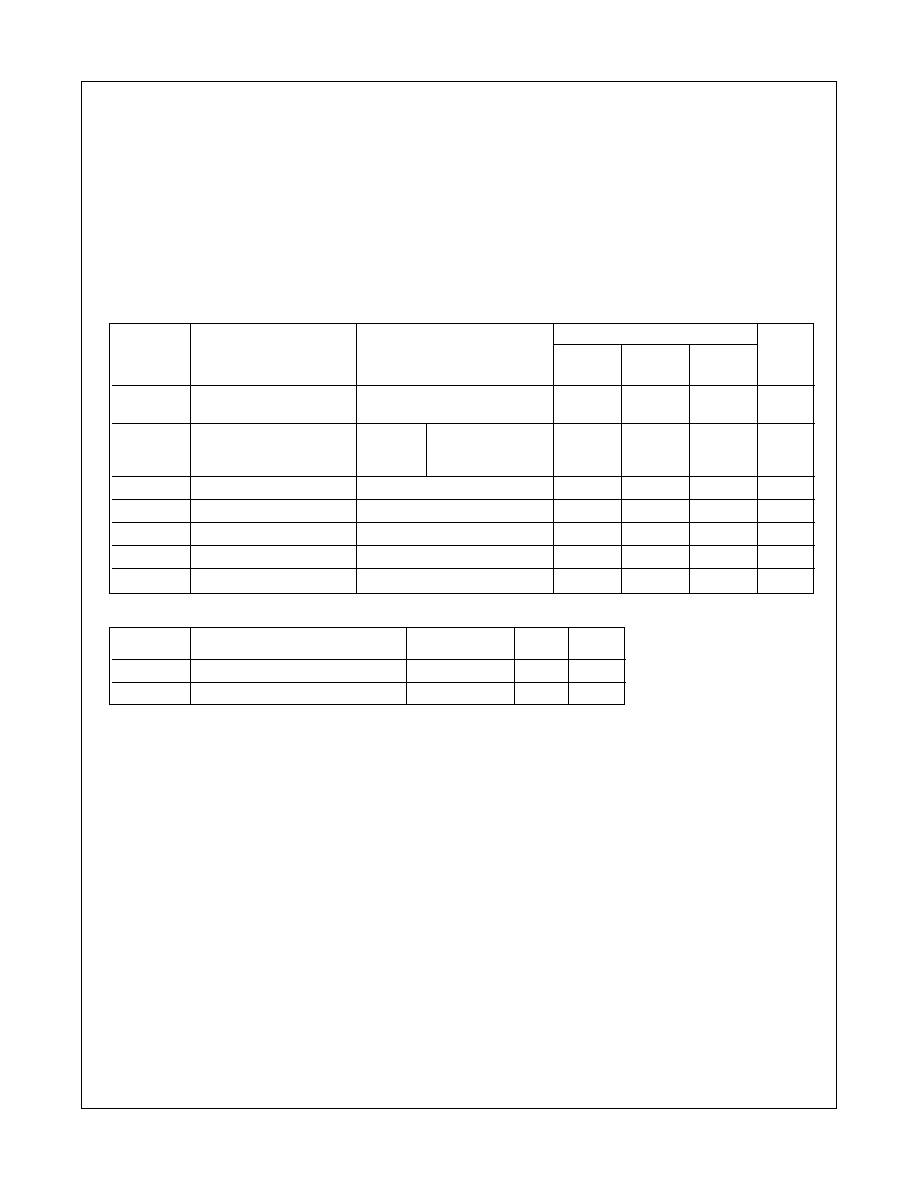
4
www.fairchildsemi.com
FM24C04U/05U Rev. A.3
FM24C04U/05U ≠ 4K-Bit Standard 2-Wire Bus Interface Serial EEPROM
Product Specifications
Absolute Maximum Ratings
Ambient Storage Temperature
≠65
∞C to +150∞C
All Input or Output Voltages
with Respect to Ground
≠0.3V to 6.5V
Lead Temperature
(Soldering, 10 seconds)
+300
∞C
ESD Rating
2000V min.
Operating Conditions
Ambient Operating Temperature
FM24C04U/05U
0
∞C to +70∞C
FM24C04UE/05UE
-40
∞C to +85∞C
FM24C04UV/05UV
-40
∞C to +125∞C
Positive Power Supply
FM24C04U/05U
4.5V to 5.5V
FM24C04UL/05UL
2.7V to 5.5V
FM24C04ULZ/05ULZ
2.7V to 5.5V
DC Electrical Characteristics (2.7V to 5.5V)
Symbol
Parameter
Test Conditions
Limits
Units
Min
Typ
Max
(Note 1)
I
CCA
Active Power Supply Current
f
SCL
= 400 KHz ("F" version)
0.2
1.0
mA
f
SCL
= 100 KHz
I
SB
Standby Current
V
IN
= GND
V
CC
= 2.7V - 5.5V
10
50
µA
(Note 3)
or V
CC
V
CC
= 2.7V - 5.5V (L)
1
10
µA
V
CC
= 2.7V - 4.5V (LZ)
0.1
1
µA
I
LI
Input Leakage Current
V
IN
= GND to V
CC
0.1
1
µA
I
LO
Output Leakage Current
V
OUT
= GND to V
CC
0.1
1
µA
V
IL
Input Low Voltage
≠0.3
V
CC
x 0.3
V
V
IH
Input High Voltage
V
CC
x 0.7
V
CC
+ 0.5
V
V
OL
Output Low Voltage
I
OL
= 3 mA
0.4
V
Capacitance
T
A
= +25
∞C, f = 100/400 KHz, V
CC
= 5V
(Note 2)
Symbol
Test
Conditions
Max
Units
C
I/O
Input/Output Capacitance (SDA)
V
I/O
= 0V
8
pF
C
IN
Input Capacitance (A0, A1, A2, SCL)
V
IN
= 0V
6
pF
Note 1: Typical values are T
A
= 25
∞C and nominal supply voltage of 5V for 4.5V-5.5V operation and at 3V for 2.7V-4.5V operation.
Note 2: This parameter is periodically sampled and not 100% tested.
Note 3: The "L" and "LZ" versions can be operated in the 2.7V to 5.5V V
CC
range. However, for a standby current (I
SB
) of 1
µA, the V
CC
should be within 2.7V to 4.5V.
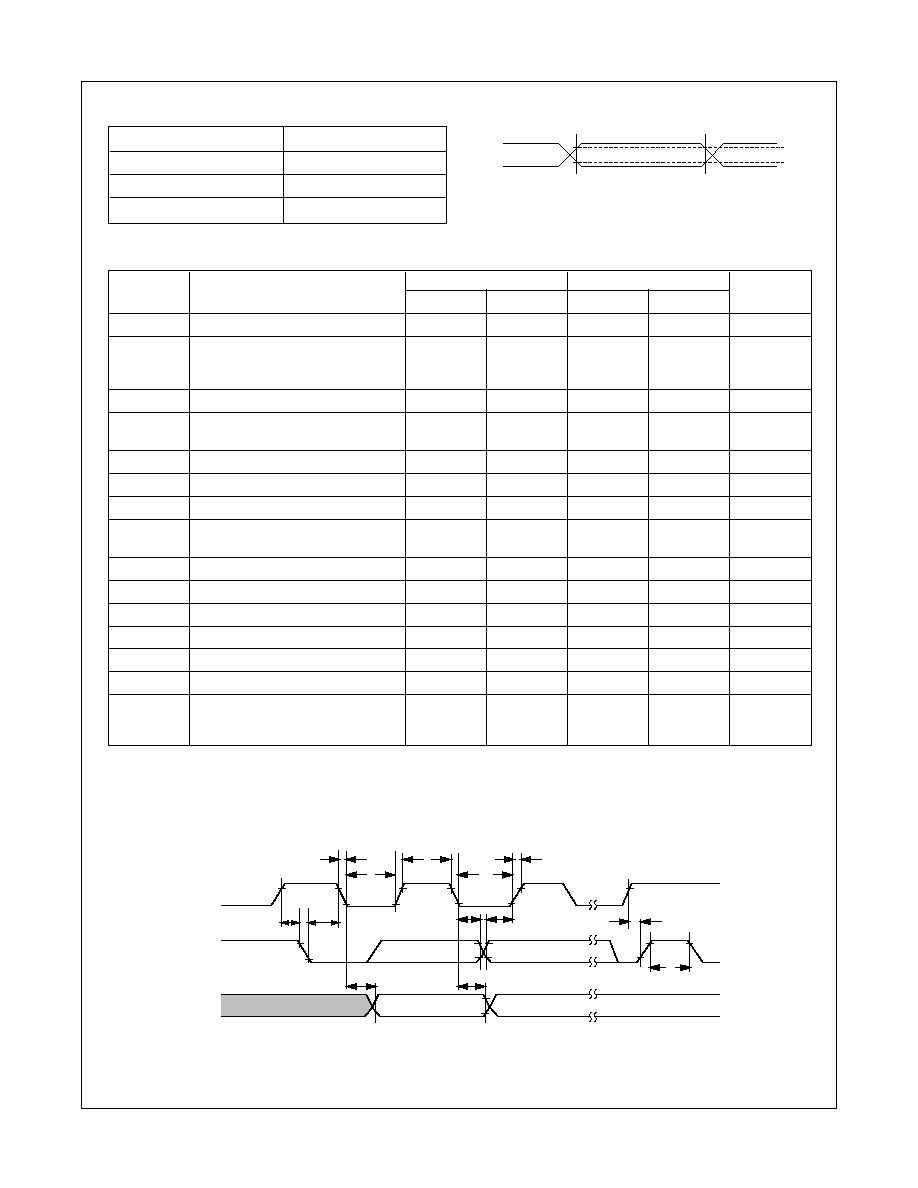
5
www.fairchildsemi.com
FM24C04U/05U Rev. A.3
FM24C04U/05U ≠ 4K-Bit Standard 2-Wire Bus Interface Serial EEPROM
AC Test Conditions
Input Pulse Levels
V
CC
x 0.1 to V
CC
x 0.9
Input Rise and Fall Times
10 ns
Input & Output Timing Levels
V
CC
x 0.3 to V
CC
x 0.7
Output Load
1 TTL Gate and C
L
= 100 pF
Bus Timing
;;
SCL
SDA
IN
SDA
OUT
tF
tLOW
tHIGH
tR
tLOW
tAA
tDH
tBUF
tSU:STA
tHD:DAT
tHD:STA
tSU:DAT
tSU:STO
0.9V
CC
0.1V
CC
0.7V
CC
0.3V
CC
Read and Write Cycle Limits (Standard and Low V
CC
Range 2.7V - 5.5V)
Symbol
Parameter
100 KHz
400 KHz
Units
Min
Max
Min
Max
f
SCL
SCL Clock Frequency
100
400
KHz
T
I
Noise Suppression Time Constant at
SCL, SDA Inputs (Minimum V
IN
100
50
ns
Pulse width)
t
AA
SCL Low to SDA Data Out Valid
0.3
3.5
0.1
0.9
µs
t
BUF
Time the Bus Must Be Free before
4.7
1.3
µs
a New Transmission Can Start
t
HD:STA
Start Condition Hold Time
4.0
0.6
µs
t
LOW
Clock Low Period
4.7
1.5
µs
t
HIGH
Clock High Period
4.0
0.6
µs
t
SU:STA
Start Condition Setup Time
4.7
0.6
µs
(for a Repeated Start Condition)
t
HD:DAT
Data in Hold Time
0
0
ns
t
SU:DAT
Data in Setup Time
250
100
ns
t
R
SDA and SCL Rise Time
1
0.3
µs
t
F
SDA and SCL Fall Time
300
300
ns
t
SU:STO
Stop Condition Setup Time
4.7
0.6
µs
t
DH
Data Out Hold Time
300
50
ns
t
WR
Write Cycle Time
(Note 4)
4.5V to 5.5V V
CC
10
10
ms
2.7V to 4.5V V
CC
15
15
Note 4: The write cycle time (t
WR
) is the time from a valid stop condition of a write sequence to the end of the internal erase/program cycle. During the write cycle, the
FM24C04U/05U bus interface circuits are disabled, SDA is allowed to remain high per the bus-level pull-up resistor, and the device does not respond to its slave address. Refer
"Write Cycle Timing" diagram.
AC Testing Input/Output Waveforms
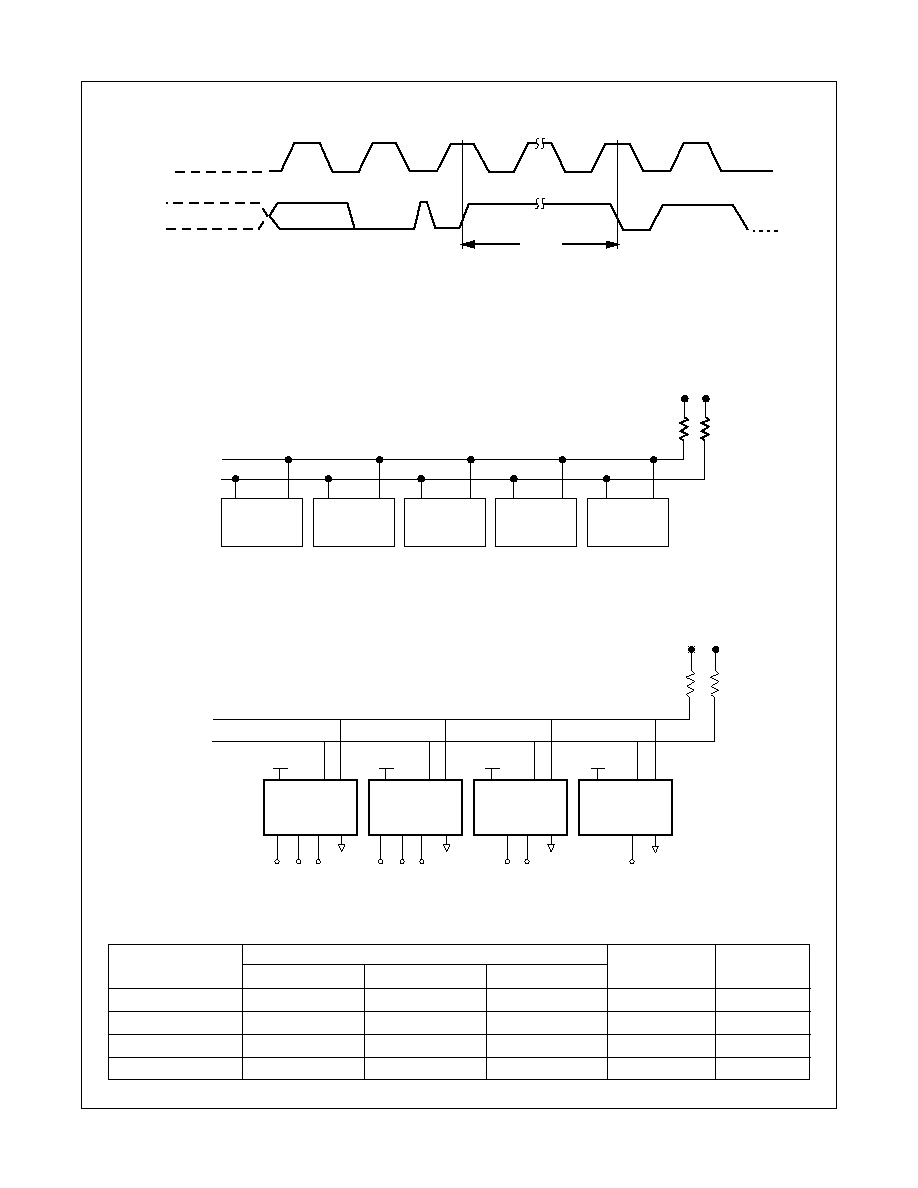
6
www.fairchildsemi.com
FM24C04U/05U Rev. A.3
FM24C04U/05U ≠ 4K-Bit Standard 2-Wire Bus Interface Serial EEPROM
SDA
SCL
Master
Transmitter/
Receiver
Slave
Transmitter/
Receiver
Master
Transmitter
Slave
Receiver
Master
Transmitter/
Receiver
VCC
VCC
SDA
SCL
24C02/03
VCC
VCC
A0 A1 A2 VSS
24C02/03
A0 A1 A2 VSS
24C04/05
A1 A2 VSS
24C08/09
A2 VSS
VCC
To
V
SS
To
V
SS
To
V
SS
VCC
VCC
VCC
To
V
CC
To
V
SS
To
V
SS
To
V
CC
To
V
SS
To
V
CC
Typical System Configuration
Note:
Due to open drain configuration of SDA and SCL, a bus-level pull-up resistor is called for, (typical value = 4.7k
)
Example of 16K of Memory on 2-Wire Bus
Note:
The SDA pull-up resistor is required due to the open-drain/open collector output of IIC bus devices.
The SCL pull-up resistor is recommended because of the normal SCL line inactive 'high' state.
It is recommended that the total line capacitance be less than 400pF
Device
Address Pins Present
Memory Size
# of Page
A0
A1
A2
Blocks
FM24C02U/03U
Yes
Yes
Yes
2048 Bits
1
FM24C04U/05U
No
Yes
Yes
4096 Bits
2
FM24C08U/09U
No
No
Yes
8192 Bits
4
FM24C16U/17U
No
No
No
16,384 Bits
8
SDA
SCL
STOP
CONDITION
START
CONDITION
WORD n
8th BIT
ACK
tWR
Write Cycle Timing
Note:
The write cycle time (t
WR
) is the time from a valid stop condition of a write sequence to the end of the internal erase/program cycle.

7
www.fairchildsemi.com
FM24C04U/05U Rev. A.3
FM24C04U/05U ≠ 4K-Bit Standard 2-Wire Bus Interface Serial EEPROM
Background Information (IIC Bus)
IIC bus allows synchronous bi-directional communication be-
tween a TRANSMITTER and a RECEIVER using a Clock signal
(SCL) and a Data signal (SDA). Additionally there are up to three
Address signals (A2, A1 and A0) which collectively serve as "chip
select signal" to a device (example EEPROM) on the IIC bus.
All communication on the IIC bus must be started with a valid
START condition (by a MASTER), followed by transmittal (by the
MASTER) of byte(s) of information (Address/Data). For every byte
of information received, the addressed RECEIVER provides a valid
ACKNOWLEDGE pulse to further continue the communication
unless the RECEIVER intends to discontinue the communication.
Depending on the direction of transfer (Write or Read), the RE-
CEIVER can be a SLAVE or the MASTER. A typical IIC communi-
cation concludes with a STOP condition (by the MASTER).
Addressing an EEPROM memory location involves sending a
command string with the following information:
[DEVICE TYPE]--[DEVICE/PAGE BLOCK SELECTION]--[R/W
BIT]--{acknowledge pulse}--[ARRAY ADDRESS]
Slave Address
Slave Address is an 8-bit information consisting of a Device type
field (4bits), Device/Page block selection field (3bits) and Read/
Write bit (1bit).
Slave Address Format
Acknowledge
Acknowledge is an active LOW pulse on the SDA line driven by an
addressed receiver to the addressing transmitter to indicate
receipt of 8-bits of data. The receiver provides an ACK pulse for
every 8-bits of data received. This handshake mechanism is done
as follows: After transmitting 8-bits of data, the transmitter re-
leases the SDA line and waits for the ACK pulse. The addressed
receiver, if present, drives the ACK pulse on the SDA line during
the 9th clock and releases the SDA line back (to the transmitter).
Refer
Figure 3.
Array Address
Array address is an 8-bit information containing the address of a
memory location to be selected within a page block of the device.
16K bit Addressing Limitation:
Standard IIC specification limits the maximum size of EEPROM
memory on the bus to 16K bits. This limitation is due to the
addressing protocol implemented which consists of the 8-bit Slave
Address and an additional 8-bit field called Array Address. This
Array Address selects 1 out of 256 locations (2
8
=256). Since the
data format of IIC specification is 8-bit wide, a total of 256 x 8 =
2048 = 2K bits now becomes addressable by this 8-bit Array
Address. These 2K bits are typically referred as a "Page Block".
Combining this 8-bit Array Address with the 3-bit Device/Page
address (part of Slave Address) allows a maximum of 8 pages
(2
3
=8) of memory that can be addressed. Since each page is 2K
bits in size, 8 x 2K bits = 16K bits is the maximum size of memory
that is addressable on the Standard IIC bus. This 16Kb of memory
can be in the form of a single 16Kb EEPROM device or multiple
EEPROMs of varying density (in 2Kb multiples) to a maximum
total of 16Kb. To address the needs of systems that require more
than 16Kb on the IIC bus, a different specification called "Ex-
tended IIC Specification" is used.
DEFINITIONS
WORD
8 bits (byte) of data
PAGE
16 sequential byte locations
starting at a 16-byte address
boundary, that may be pro-
grammed during a "page write"
programming cycle
PAGE BLOCK
2048 (2K) bits organized into 16
pages of addressable memory. (8
bits) x (16 bytes) x (16 pages) =
2048 bits
MASTER
Any IIC device CONTROLLING the
transfer of data (such as a
microprocessor)
SLAVE
Device being controlled
(EEPROMs are always considered
Slaves)
TRANSMITTER
Device currently SENDING data on
the bus (may be either a Master or
Slave).
RECEIVER
Device currently RECEIVING data
on the bus (Master or Slave)
Device Type
Identifier
Device/Page Block
Selection
1
0
1
0
A2
A1
A0
R/W
(LSB)
Device Type
IIC bus is designed to support a variety of devices such as RAMs,
EPROMs etc., along with EEPROMS. Hence to properly identify
various devices on the IIC bus, a 4-bit "Device Type" identifier
string is used. For EEPROMS, this 4-bit string is 1-0-1-0. Every IIC
device on the bus internally compares this 4-bit string to its own
"Device Type" string to ensure proper device selection.
Device/Page Block Selection
When multiple devices of the same type (e.g. multiple EEPROMS)
are present on the IIC bus, then the A2, A1 and A0 address
information bits are also used as part of the Slave Address. Every
IIC device on the bus internally compares this 3-bit string to its own
physical configuration (A2, A1 and A0 pins) to ensure proper
device selection. This comparison is in addition to the "Device
Type" comparison. In addition to selecting an EEPROM, these 3
bits are also used to select a "page block" within the selected
EEPROM. Each page block is 2Kbit (256Bytes) in size. Depend-
ing on the density, an EEPROM can contain from a minimum of 1
to a maximum of 8 page blocks (in multiples of 2) and selection of
a page block within a device is by using A2, A1 and A0 bits.
Read/Write Bit
Last bit of the Slave Address indicates if the intended access is
Read or Write. If the bit is "1," then the access is Read, whereas
if the bit is "0," then the access is Write.
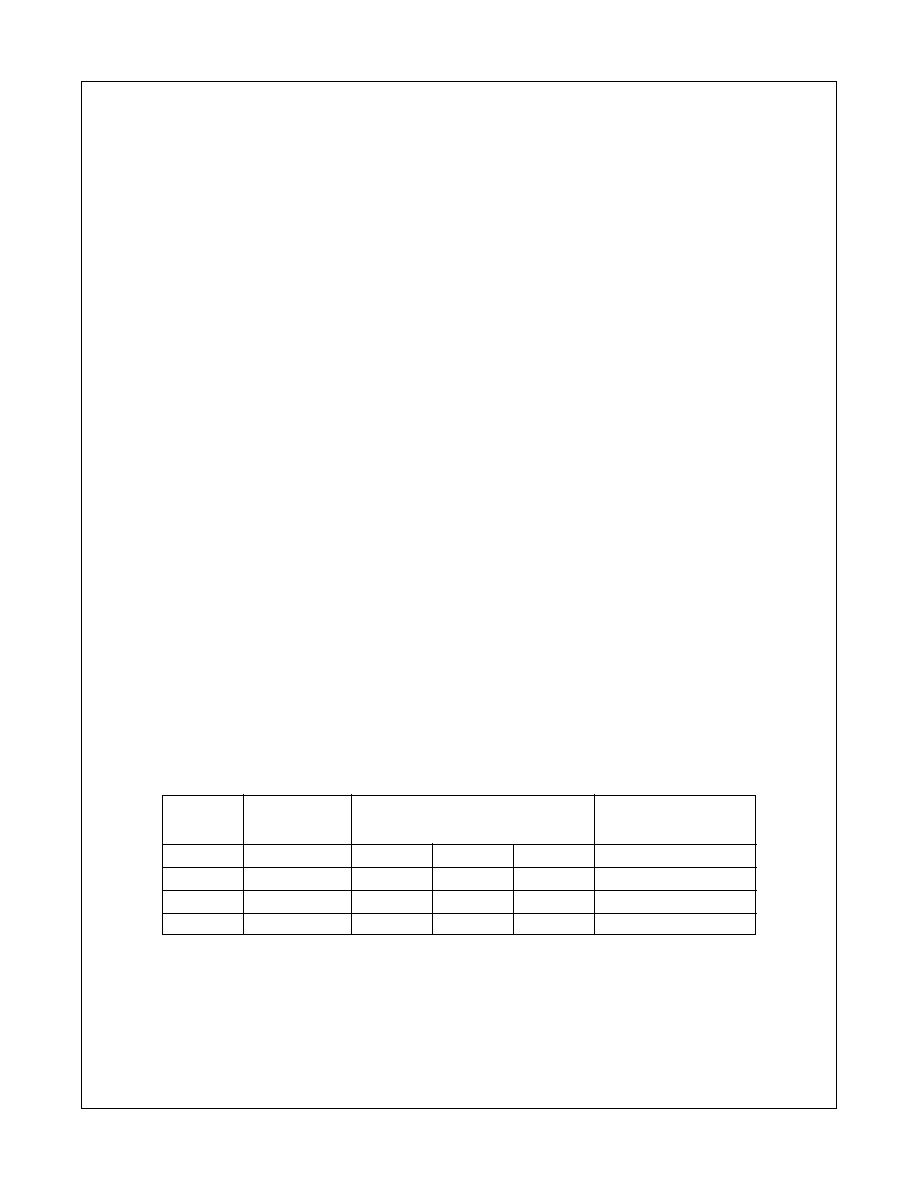
8
www.fairchildsemi.com
FM24C04U/05U Rev. A.3
FM24C04U/05U ≠ 4K-Bit Standard 2-Wire Bus Interface Serial EEPROM
EEPROM
Number of
Device Selection Inputs
Address Bits
Density
Page Blocks
Provided
Selecting Page Block
2k bit
1
A0
A1
A2
None
4k bit
2
--
A1
A2
A0
8k bit
4
--
--
A2
A0 and A1
16k bit
8
--
--
--
A0, A1 and A2
Pin Descriptions
Serial Clock (SCL)
The SCL input is used to clock all data into and out of the device.
Serial Data (SDA)
SDA is a bi-directional pin used to transfer data into and out of the
device. It is an open drain output and may be wire≠ORed with any
number of open drain or open collector outputs.
Write Protect (WP) (FM24C05U Only)
If tied to V
CC
, PROGRAM operations onto the upper half (upper
2Kbits) of the memory will not be executed. READ operations are
possible. If tied to V
SS
, normal operation is enabled, READ/
WRITE over the entire memory is possible.
This feature allows the user to assign the upper half of the memory
as ROM which can be protected against accidental programming.
When write is disabled, slave address and word address will be
acknowledged but data will not be acknowledged.
This pin has an internal pull-down circuit. However, on systems
where write protection is not required it is recommended that this
pin is tied to V
SS
.
Device Selection Inputs A2, A1 and A0 (as
appropriate)
These inputs collectively serve as "chip select" signal to an
EEPROM when multiple EEPROMs are present on the same IIC
bus. Hence these inputs, if present, should be connected to V
CC
or V
SS
in a unique manner to allow proper selection of an EEPROM
amongst multiple EEPROMs. During a typical addressing se-
quence, every EEPROM on the IIC bus compares the configura-
tion of these inputs to the respective 3 bit "Device/Page block
selection" information (part of slave address) to determine a valid
selection. For e.g. if the 3 bit "Device/Page block selection" is 1-
0-1, then the EEPROM whose "Device Selection inputs" (A2, A1
and A0) are connected to V
CC
-V
SS
-V
CC
respectively, is selected.
Depending on the density, only appropriate numbers of "Device
Selection inputs" are provided on an EEPROM. For every "Device
selection input" that is not present on the device, the correspond-
ing bit in the "Device/Page block selection" field is used to select
a "Page Block" within the device instead of the device itself.
Following table illustrates the above:
Note that even when just one EEPROM present on the IIC bus,
these pins should be tied to V
CC
or V
SS
to ensure proper termina-
tion.
Device Operation
The FM24C04U/05U supports a bi-directional bus oriented proto-
col. The protocol defines any device that sends data onto the bus
as a transmitter and the receiving device as the receiver. The
device controlling the transfer is the master and the device that is
controlled is the slave. The master will always initiate data
transfers and provide the clock for both transmit and receive
operations. Therefore, the FM24C04U/05U will be considered a
slave in all applications.
Clock and Data Conventions
Data states on the SDA line can change only during SCL LOW.
SDA state changes during SCL HIGH are reserved for indicating
start and stop conditions. Refer to
Figure 1 and Figure 2 on next
page.
Start Condition
All commands are preceded by the start condition, which is a
HIGH to LOW transition of SDA when SCL is HIGH. The
FM24C04U/05U continuously monitors the SDA and SCL lines for
the start condition and will not respond to any command until this
condition has been met.
Stop Condition
All communications are terminated by a stop condition, which is a
LOW to HIGH transition of SDA when SCL is HIGH. The stop
condition is also used by the FM24C04U/05U to place the device
in the standby power mode, except when a Write operation is
being executed, in which case a second stop condition is required
after t
WR
period, to place the device in standby mode.
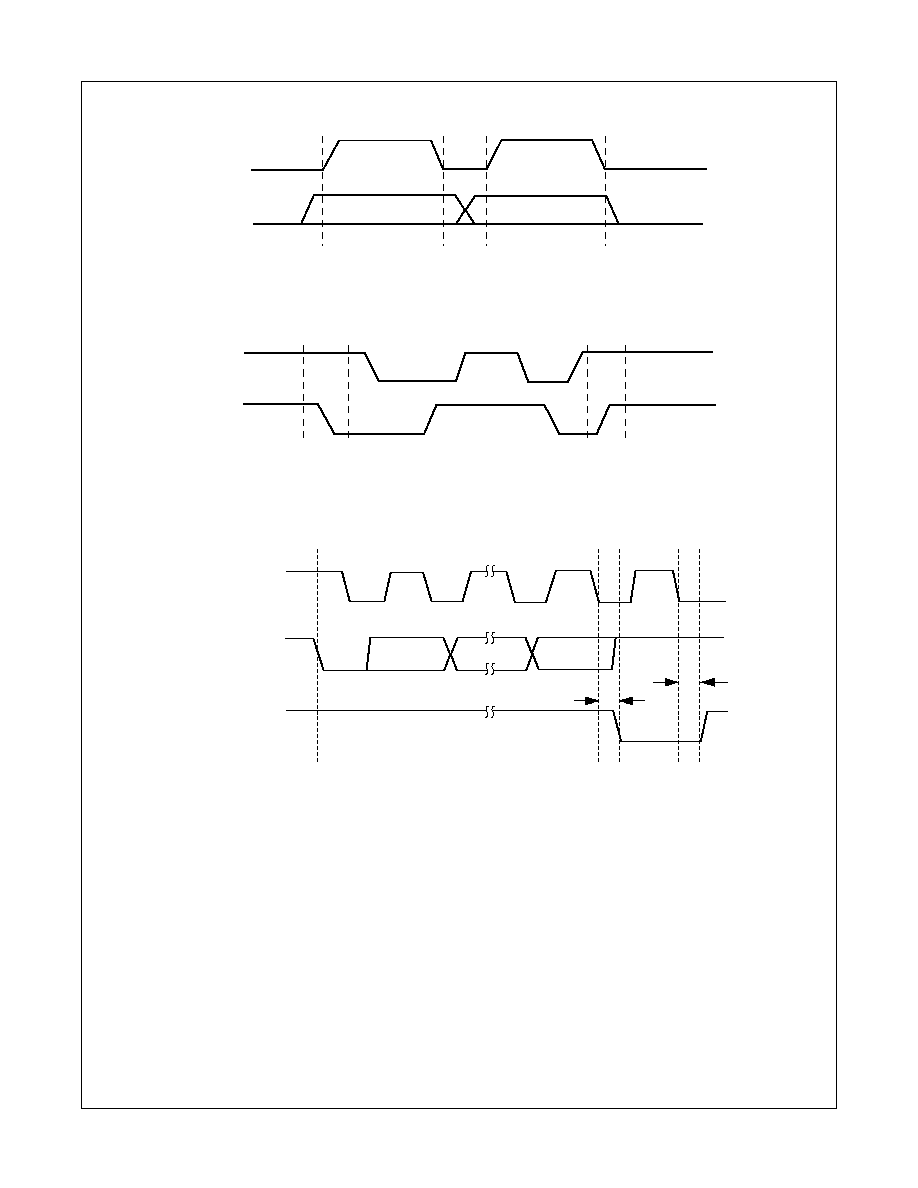
9
www.fairchildsemi.com
FM24C04U/05U Rev. A.3
FM24C04U/05U ≠ 4K-Bit Standard 2-Wire Bus Interface Serial EEPROM
Data Validity (Figure 1)
Start and Stop Definition (Figure 2)
SCL FROM
MASTER
DATA OUTPUT
FROM
TRANSMITTER
DATA OUTPUT
FROM
RECEIVER
1
8
9
START
CONDITION
ACKNOWLEDGE
PULSE
tAA
tDH
SDA
SCL
START
CONDITION
STOP
CONDITION
SCL
DATA STABLE
DATA
CHANGE
SDA
Acknowledge Response from Receiver (Figure 3)
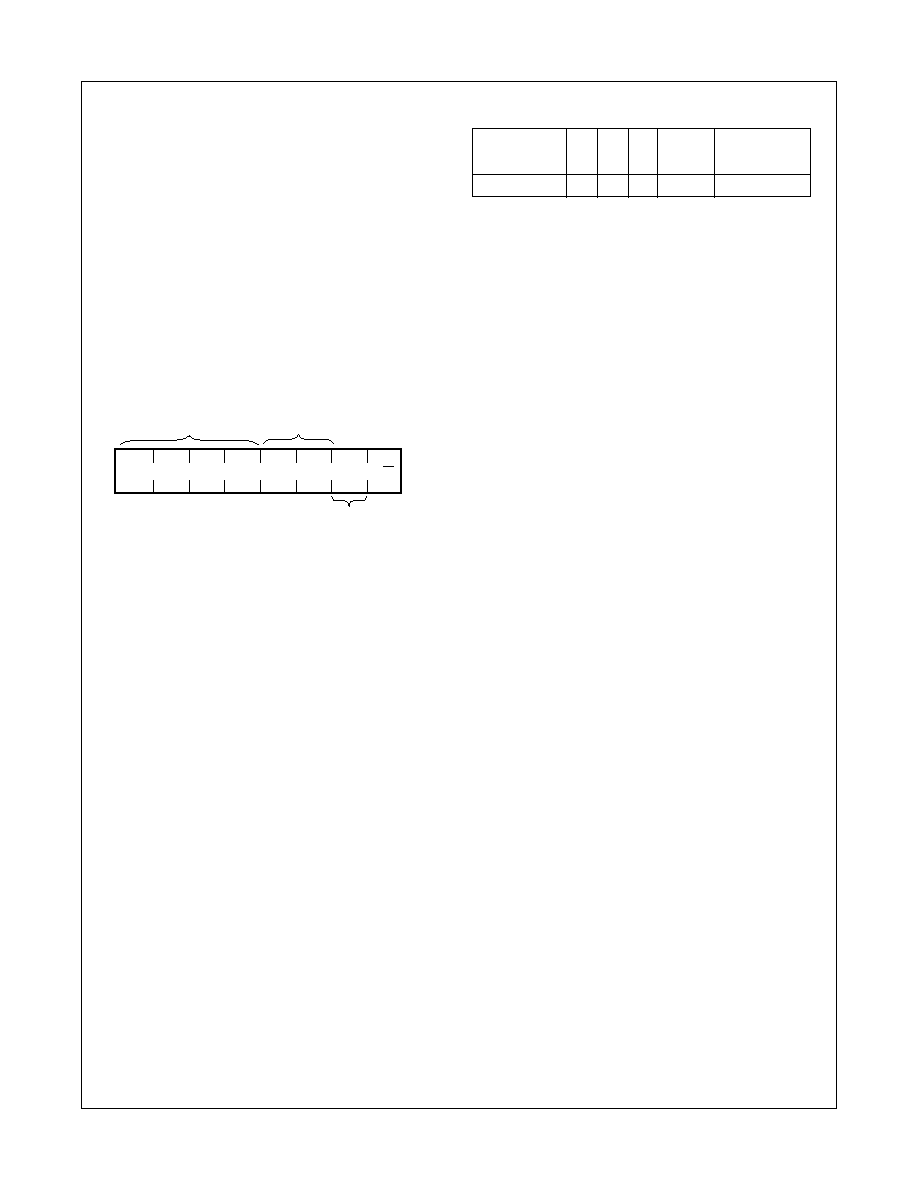
10
www.fairchildsemi.com
FM24C04U/05U Rev. A.3
FM24C04U/05U ≠ 4K-Bit Standard 2-Wire Bus Interface Serial EEPROM
Acknowledge
The FM24C04U/05U device will always respond with an acknowl-
edge after recognition of a start condition and its slave address. If
both the device and a write operation have been selected, the
FM24C04U/05U will respond with an acknowledge after the
receipt of each subsequent eight bit byte.
In the read mode the FM24C04U/05U slave will transmit eight bits
of data, release the SDA line and monitor the line for an acknowl-
edge. If an acknowledge is detected, FM24C04U/05U will continue
to transmit data. If an acknowledge is not detected,FM24C04U/05U
will terminate further data transmissions and await the stop condi-
tion to return to the standby power mode.
Device Addressing
Following a start condition the master must output the address of
the slave it is accessing. The most significant four bits of the slave
address are those of the device type identifier. This is fixed as
1010 for all EEPROM devices.
Refer the following table for Slave Addresses string details:
Device
A0 A1 A2
Page
Page Block
Blocks Addresses
FM24C04U/05U
P
A
A
2
0, 1
A: Refers to a hardware configured Device Address pin.
P: Refers to an internal PAGE BLOCK.
All IIC EEPROMs use an internal protocol that defines a PAGE
BLOCK size of 2K bits (for Word addresses 0x00 through 0xFF).
Therefore, address bits A0, A1, or A2 (if designated 'P') are used
to access a PAGE BLOCK in conjunction with the Word address
used to access any individual data byte.
The last bit of the slave address defines whether a write or read
condition is requested by the master. A '1' indicates that a read
operation is to be executed, and a '0' initiates the write mode.
A simple review: After the FM24C04U/05U recognizes the start
condition, the devices interfaced to the IIC bus wait for a slave
address to be transmitted over the SDA line. If the transmitted
slave address matches an address of one of the devices, the
designated slave pulls the SDA line LOW with an acknowledge
signal and awaits further transmissions.
Device Type
Identifier
Device
Address
1
0
1
0
A2
A1
A0
R/W
(LSB)
24C04/05
Page
Block Address

11
www.fairchildsemi.com
FM24C04U/05U Rev. A.3
FM24C04U/05U ≠ 4K-Bit Standard 2-Wire Bus Interface Serial EEPROM
Write Operations
BYTE WRITE
For a write operation, a second address field is required which is a
word address that is comprised of eight bits and provides access to
any one of the 256 bytes in the selected page of memory. Upon
receipt of the byte address, the FM24C04U/05U responds with an
acknowledge and waits for the next eight bits of data, again,
responding with an acknowledge. The master then terminates the
transfer by generating a stop condition at which time the FM24C04U/
05U begins the internal write cycle to the nonvolatile memory. While
the internal write cycle is in progress, the FM24C04U/05U inputs
are disabled, and the device will not respond to any requests from
the master for the duration of t
WR
. Refer to
Figure 4 for the address,
acknowledge, and data transfer sequence.
PAGE WRITE
To minimize write cycle time, FM24C04U/05U offer Page Write
feature, by which, up to a maximum of 16 contiguous byte
locations can be programmed all at once (instead of 16 individual
byte writes). To facilitate this feature, the memory array is orga-
nized in terms of "Pages." A Page consists of 16 contiguous byte
locations starting at every 16-Byte address boundary (for ex-
ample, starting at array address 0x00, 0x10, 0x20 etc.). Page
Write operation limits access to byte locations within a page. In
other words a single Page Write operation will not cross over to
locations on another page but will "roll over" to the beginning of the
page whenever end of Page is reached and additional locations
are continued to be accessed. A Page Write operation can be
initiated to begin at any location within a page (starting address of
the Page Write operation need not be the starting address of a
Page).
S
T
O
P
Bus Activity:
Master
SDA Line
Bus Activity:
EEPROM
DATA n + 15
DATA n + 1
DATA n
WORD ADDRESS (n)
A
C
K
S
T
A
R
T
SLAVE
ADDRESS
A
C
K
A
C
K
A
C
K
A
C
K
S
T
O
P
A
C
K
DATA
A
C
K
A
C
K
S
T
A
R
T
WORD
ADDRESS
SLAVE
ADDRESS
Bus Activity:
Master
SDA Line
Bus Activity:
EEPROM
Page Write is initiated in the same manner as the Byte Write
operation; but instead of terminating the cycle after transmitting
the first data byte, the master can further transmit up to 15 more
bytes. After the receipt of each byte, FM24C04U/05U will respond
with an acknowledge pulse, increment the internal address counter
to the next address, and is ready to accept the next data. If the
master should transmit more than sixteen bytes prior to generat-
ing the STOP condition, the address counter will "roll over" and
previously written data will be overwritten. As with the Byte Write
operation, all inputs are disabled until completion of the internal
write cycle. Refer to
Figure 5 for the address, acknowledge, and
data transfer sequence.
Acknowledge Polling
Once the stop condition is issued to indicate the end of the host's
write operation, the FM24C04U/05U initiates the internal write
cycle. ACK polling can be initiated immediately. This involves
issuing the start condition followed by the slave address for a write
operation. If the FM24C04U/05U is still busy with the write
operation no ACK will be returned. If the FM24C04U/05U has
completed the write operation, an ACK will be returned and the
host can then proceed with the next read or write operation.
Write Protection (FM24C05U Only)
Programming of the upper half (upper 2Kbit) of the memory will not
take place if the WP pin of the FM24C05U is connected to V
CC
.
The FM24C05U will respond to slave and byte addresses; but if
the memory accessed is write protected by the WP pin, the
FM24C05U will not generate an acknowledge after the first byte
of data has been received. Thus, the program cycle will not be
started when the stop condition is asserted.
Byte Write (Figure 4)
Page Write (Figure 5)
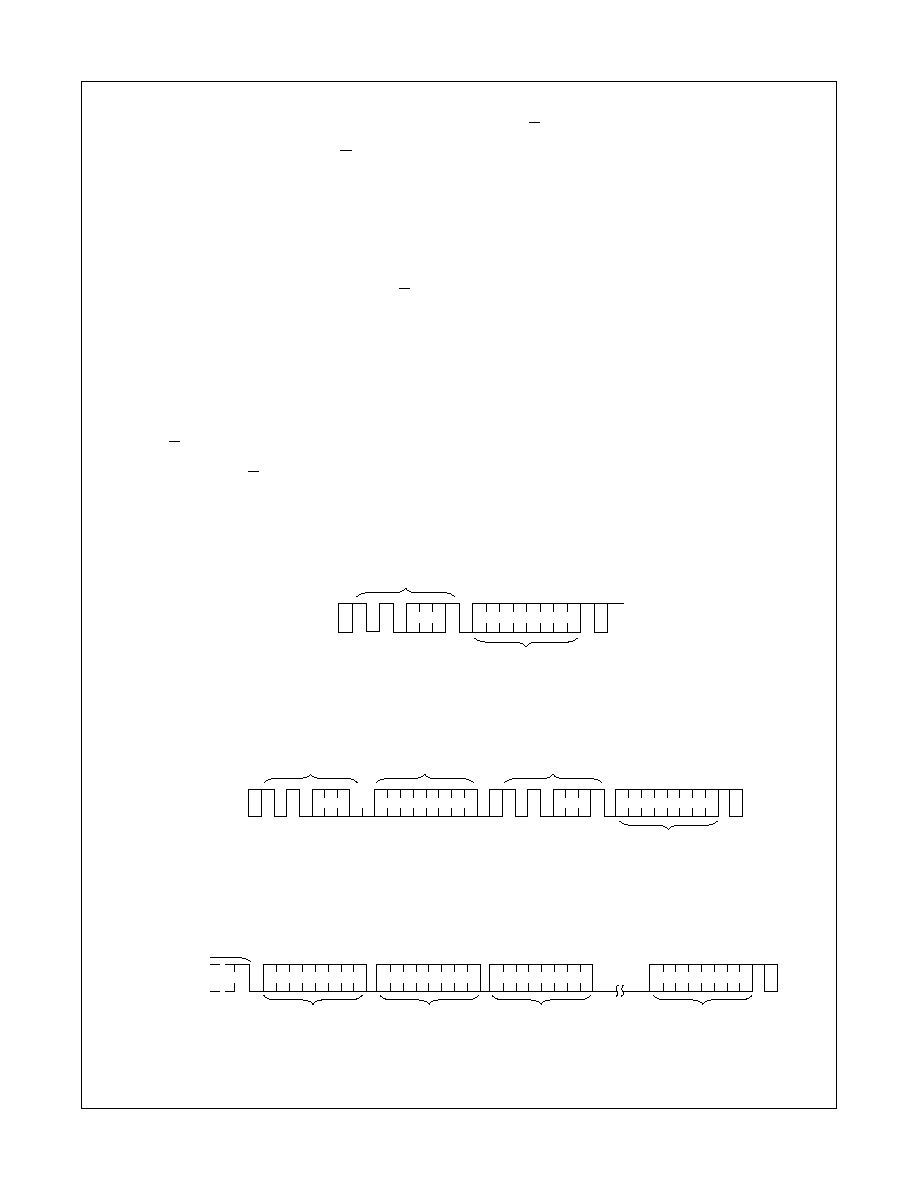
12
www.fairchildsemi.com
FM24C04U/05U Rev. A.3
FM24C04U/05U ≠ 4K-Bit Standard 2-Wire Bus Interface Serial EEPROM
S
T
O
P
A
C
K
NO
A
C
K
SLAVE
ADDRESS
A
C
K
A
C
K
S
T
A
R
T
S
T
A
R
T
WORD
ADDRESS
SLAVE
ADDRESS
Bus Activity:
Master
SDA Line
Bus Activity:
EEPROM
DATA n
S
T
O
P
A
C
K
Bus Activity:
Master
SDA Line
Bus Activity:
EEPROM
A
C
K
DATA n + x
A
C
K
DATA n + 2
DATA n +1
DATA n +1
A
C
K
NO
A
C
K
Slave
Address
Read Operations
Read operations are initiated in the same manner as write
operations, with the exception that the R/W bit of the slave
address is set to a one. There are three basic read operations:
current address read, random read, and sequential read.
Current Address Read
Internally the FM24C04U/05U contains an address counter that
maintains the address of the last byte accessed, incremented by
one. Therefore, if the last access (either a read or write) was to
address n, the next read operation would access data from
address n + 1. Upon receipt of the slave address with R/W set to
one, the FM24C04U/05U issues an acknowledge and transmits
the eight bit word. The master will not acknowledge the transfer
but does generate a stop condition, and therefore the FM24C04U/
05U discontinues transmission. Refer to
Figure 6 for the se-
quence of address, acknowledge and data transfer.
Random Read
Random read operations allow the master to access any memory
location in a random manner. Prior to issuing the slave address
with the R/W bit set to one, the master must first perform a
"dummy" write operation. The master issues the start condition,
slave address with the R/W bit set to zero and then the byte
address is read. After the byte address acknowledge, the master
immediately issues another start condition and the slave address
with the R/W bit set to one. This will be followed by an acknowl-
edge from the FM24C04U/05U and then by the eight bit word. The
master will not acknowledge the transfer but does generate the
stop condition, and therefore the FM24C04U/05U discontinues
transmission. Refer to
Figure 7 for the address, acknowledge, and
data transfer sequence.
Sequential Read
Sequential reads can be initiated as either a current address read
or random access read. The first word is transmitted in the same
manner as the other read modes; however, the master now
responds with an acknowledge, indicating it requires additional
data. The FM24C04U/05U continues to output data for each
acknowledge received. The read operation is terminated by the
master not responding with an acknowledge or by generating a
stop condition.
The data output is sequential with the data from address n
followed by the data from n + 1. The address counter for read
operations increments all word address bits, allowing the entire
memory contents to be serially read during one operation. After
the entire memory has been read, the counter "rolls over" to the
beginning of the memory. FM24C04U/05U continues to output
data for each acknowledge received. Refer to
Figure 8 for the
address, acknowledge, and data transfer sequence.
Current Address Read (Figure 6)
S
T
O
P
DATA
A
C
K
NO
A
C
K
S
T
A
R
T
SLAVE
ADDRESS
Bus Activity:
Master
SDA Line
Bus Activity:
EEPROM
1 0 1 0 1
Random Read (Figure 7)
Sequential Read (Figure 8)
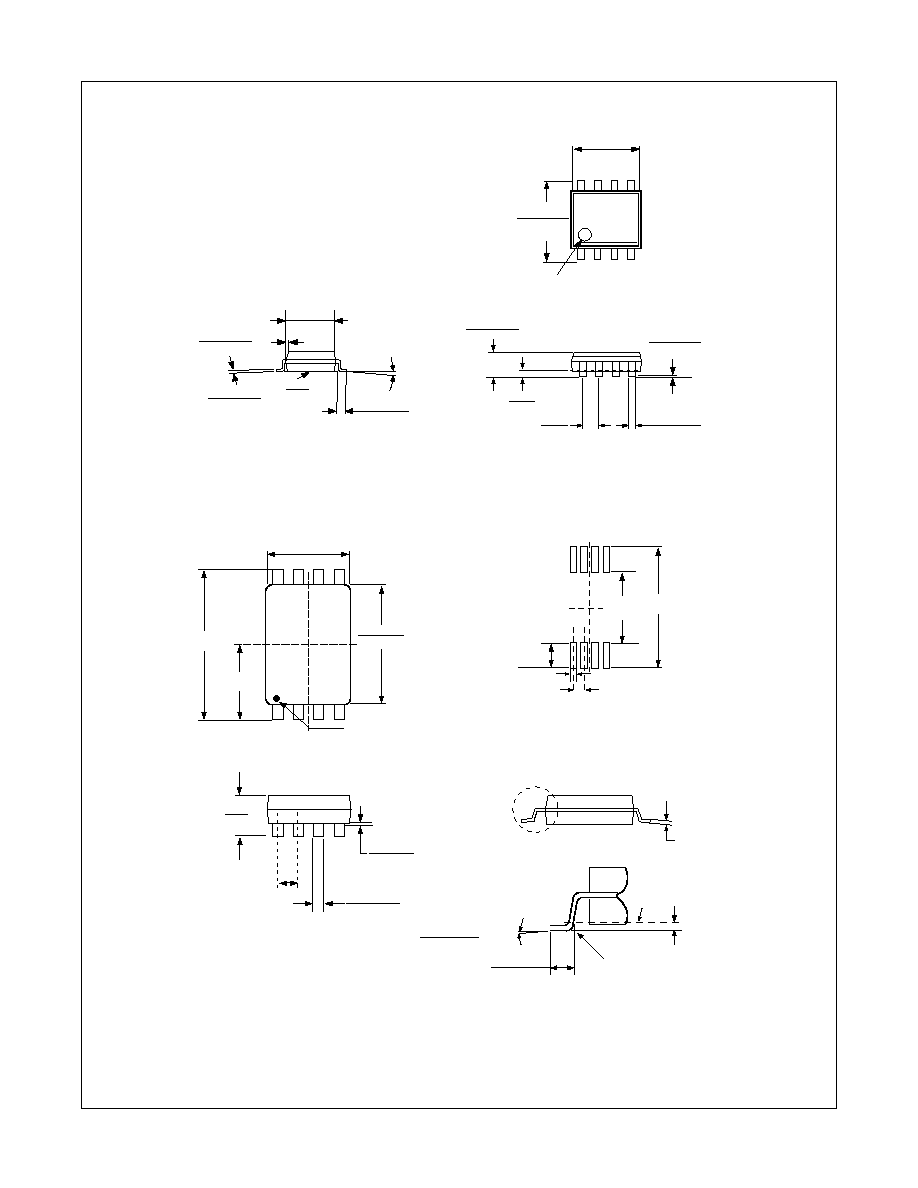
13
www.fairchildsemi.com
FM24C04U/05U Rev. A.3
FM24C04U/05U ≠ 4K-Bit Standard 2-Wire Bus Interface Serial EEPROM
8-Pin Molded Small Outline Package (M8)
Package Number M08A
Physical Dimensions
inches (millimeters) unless otherwise noted
8-Pin Molded Thin Shrink Small Outline Package (MT8)
Package Number MTC08
1
2
3 4
8
7
6 5
0.189 - 0.197
(4.800 - 5.004)
0.228 - 0.244
(5.791 - 6.198)
Lead #1
IDENT
Seating
Plane
0.004 - 0.010
(0.102 - 0.254)
0.014 - 0.020
(0.356 - 0.508)
0.014
(0.356)
Typ.
0.053 - 0.069
(1.346 - 1.753)
0.050
(1.270)
Typ
0.016 - 0.050
(0.406 - 1.270)
Typ. All Leads
8° Max, Typ.
All leads
0.150 - 0.157
(3.810 - 3.988)
0.0075 - 0.0098
(0.190 - 0.249)
Typ. All Leads
0.004
(0.102)
All lead tips
0.010 - 0.020
(0.254 - 0.508)
x 45°
0.114 - 0.122
(2.90 - 3.10)
0.123 - 0.128
(3.13 - 3.30)
0.246 - 0.256
(6.25 - 6.5)
1
4
8
5
0.169 - 0.177
(4.30 - 4.50)
(7.72) Typ
(4.16) Typ
(1.78) Typ
(0.42) Typ
(0.65) Typ
0.002 - 0.006
(0.05 - 0.15)
0.0256 (0.65)
Typ.
0.0433
(1.1)
Max
0.0075 - 0.0118
(0.19 - 0.30)
Pin #1 IDENT
0.0035 - 0.0079
0°-8°
0.020 - 0.028
(0.50 - 0.70)
0.0075 - 0.0098
(0.19 - 0.25)
Seating
plane
Gage
plane
See detail A
Notes: Unless otherwise specified
1. Reference JEDEC registration MO153. Variation AA. Dated 7/93
Land pattern recommendation
DETAIL A
Typ. Scale: 40X
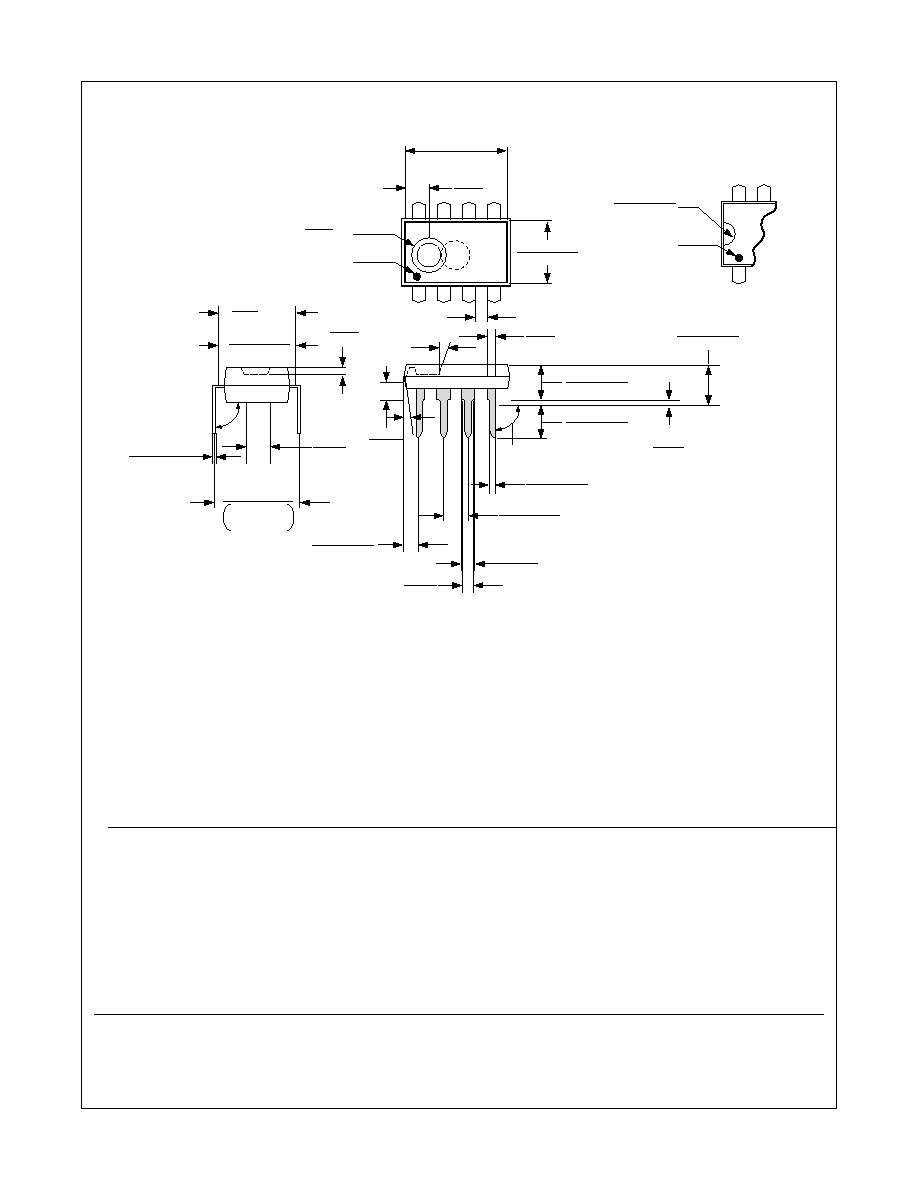
14
www.fairchildsemi.com
FM24C04U/05U Rev. A.3
FM24C04U/05U ≠ 4K-Bit Standard 2-Wire Bus Interface Serial EEPROM
Physical Dimensions
inches (millimeters) unless otherwise noted
Fairchild does not assume any responsibility for use of any circuitry described, no circuit patent licenses are implied and Fairchild reserves the right at any time without notice to change said circuitry and specifications.
Life Support Policy
Fairchild's products are not authorized for use as critical components in life support devices or systems without the express written
approval of the President of Fairchild Semiconductor Corporation. As used herein:
1. Life support devices or systems are devices or systems which,
(a) are intended for surgical implant into the body, or (b) support
or sustain life, and whose failure to perform, when properly
used in accordance with instructions for use provided in the
labeling, can be reasonably expected to result in a significant
injury to the user.
2. A critical component is any component of a life support device
or system whose failure to perform can be reasonably ex-
pected to cause the failure of the life support device or system,
or to affect its safety or effectiveness.
Fairchild Semiconductor
Fairchild Semiconductor
Fairchild Semiconductor
Fairchild Semiconductor
Americas
Europe
Hong Kong
Japan Ltd.
Customer Response Center
Fax:
+44 (0) 1793-856858
8/F, Room 808, Empire Centre
4F, Natsume Bldg.
Tel. 1-888-522-5372
Deutsch
Tel:
+49 (0) 8141-6102-0
68 Mody Road, Tsimshatsui East
2-18-6, Yushima, Bunkyo-ku
English
Tel:
+44 (0) 1793-856856
Kowloon. Hong Kong
Tokyo, 113-0034 Japan
FranÁais
Tel:
+33 (0) 1-6930-3696
Tel; +852-2722-8338
Tel: 81-3-3818-8840
Italiano
Tel:
+39 (0) 2-249111-1
Fax: +852-2722-8383
Fax: 81-3-3818-8841
Molded Dual-In-Line Package (N)
Package Number N08E
0.373 - 0.400
(9.474 - 10.16)
0.092
(2.337)
DIA
+
1
2
3
4
8
7
6
5
0.250 - 0.005
(6.35 ± 0.127)
8
7
0.032 ± 0.005
(0.813 ± 0.127)
Pin #1
Option 2
RAD
1
0.145 - 0.200
(3.683 - 5.080)
0.130 ± 0.005
(3.302 ± 0.127)
0.125 - 0.140
(3.175 - 3.556)
0.020
(0.508)
Min
0.018 ± 0.003
(0.457 ± 0.076)
90∞ ± 4∞
Typ
0.100 ± 0.010
(2.540 ± 0.254)
0.040
(1.016)
0.039
(0.991)
Typ.
20∞ ± 1∞
0.065
(1.651)
0.050
(1.270)
0.060
(1.524)
Pin #1 IDENT
Option 1
0.280 MIN
0.300 - 0.320
(7.62 - 8.128)
0.030
(0.762)
MAX
0.125
(3.175)
DIA
NOM
0.009 - 0.015
(0.229 - 0.381)
0.045 ± 0.015
(1.143 ± 0.381)
0.325
+0.040
-0.015
8.255
+1.016
-0.381
95∞ ± 5∞
0.090
(2.286)
(7.112)
IDENT













